Shevlin Sebastian's Blog, page 102
October 22, 2015
Before the whistle blows....
 The energy and enthusiasm shown by the crowd before the start of an Indian Super League match at Kochi is infectious
The energy and enthusiasm shown by the crowd before the start of an Indian Super League match at Kochi is infectious By Shevlin Sebastian “Am I the only girl who has come to see the match?” says 14-year-old Sneha, as she walks on the road just outside the Jawaharlal Nehru stadium at Kochi on Sunday. This is an hour before the start of the Indian Super League (ISL) match between Kerala Blasters (KB) and the Delhi Dynamos. Indeed, for a moment, she seems to be right. And, on the dot, at 7 p.m., the match begins. Or, as the theme song of the ISL says, ‘C’mon India, let’s football’.
Published on October 22, 2015 22:00
October 19, 2015
I Am Always Yours

 COLUMN: Spouse's Turn
COLUMN: Spouse's Turn Niju talks about life with the film director RS Vimal
Photos by Manu R. Mavelil
By Shevlin Sebastian
The first time Niju met Vimal was when he came to her house, in August, 2006, at Karakonam, for an ‘arranged marriage meeting’. Vimal was wearing a green shirt and blue jeans, and she liked him immediately.
That was because Niju had an image in her mind of a prospective husband. He should be fair and mature. In both aspects, Vimal fitted the bill. The feeling was mutual. Even before he reached his home, at Thiruvananthapuram, Vimal called and said yes. Within a week, the marriage was fixed.
During the fixing ceremony, Vimal gave Niju three photographs of himself. In one, he had inscribed the words, ‘From Me To You’. Niju was touched. Later, her sister, Shinu, pasted all the three photographs on the wall of their bedroom.
The pair got married on November 5, 2006 at the Gautham auditorium in Kunnathukal. And it seemed the Gods smiled at them. “There was heavy rain a day before, and rains after that,” says Niju. “But on our wedding day, there was no rain whatsoever.”
At that time Vimal was a producer in a television channel, while Niju worked as a teacher at a college in Manjalumoodu. Since she had only a few days of leave, they could not go for a honeymoon. Instead, they prayed at a few temples in Tamil Nadu.
However, within a month, Niju got pregnant. This turned out to be their only child, daughter Adhvaitha.
According to Niju, Vimal changed when he became a father. “Even though Adhvaitha is eight years old, he treats her as if she is five months old,” she says. “But then fathers always have a special closeness with their daughters.”
As for his other qualities, Niju says that Vimal is a caring person. “He looks after me very well,” she says. “In the early years, he would do everything for me, including shopping for vegetables.”
But the quality that Niju likes the most about Vimal is his kindness. “Vimal helps poor people a lot,” says Niju. “Once, while going for a wedding at Thiruvananthapuram, we met a man who belonged to Vimal's hometown. He did not look good, so Vimal gave him some money. He always buys food for beggars on the street.”
Perhaps the only negative is that Vimal gets angry very quickly. “He is a straight-forward person, but I always tell him that in order to survive in society, this may not be the right way,” says Niju. “But Vimal says that he cannot change.”
Today, the couple is basking in the huge success of Vimal’s debut film, ‘Ennu Ninte Moideen’. But it had not been easy. Six years ago, one day, when Niju was returning on a bus, after completing her M. Phil exams, Vimal called and said that he was quitting his job. “He said he had got a chance to do a film,” says Niju. “I told him to go ahead.”
Vimal got the idea to do a film when he did a television documentary on the forbidden love between a Muslim, Moideen, and a Hindu woman by the name of Kanchana Mala at Mukkom. Both families opposed the love. So, they could not marry. Unfortunately Moideen died, at age 44, on the Iruvanjipuzha River while trying to save passengers on a boat-wreck.
“Vimal would discuss the outline of the story with me,” says Niju. “Whenever he asked for my opinion, I would give it. Otherwise, I did not interfere at all.”
But Niju never imagined that it would take five long years to complete the film. “There were various reasons for the delay,” says Niju. Not surprisingly, it was a time of great tension for Vimal. There were nights when he could not go to sleep. “I was also worried,” she says. Somehow, Niju remained busy in her job as an assistant professor of mathematics at a college in Parippally.
Finally, early this year, Niju saw parts of the film at Vismaya Studio in Thiruvananthapuram. And some scenes affected her deeply. “I thought: is it because it was my husband’s film that I was reacting so intensely?” she says. “I did wonder whether the audience would have a similar reaction.”
She got the answer during the first show, at the Kairali theatre, in Thiruvananthapuram, on September 19. “I kept getting text messages saying that it is a good film and felt thrilled about that,” she says. Later, Niju distributed laddoos to all the students, teachers and non-teaching staff of her college. And, today, she has a simple desire. “My deepest wish is that all of Vimal’s future films should also do as well,” she says.
Finally, when asked to give tips for a successful marriage, Niju says, “There will be problems in every marriage, but you should adopt a positive attitude towards solving it. Spouses should offer support, and avoid interfering in each other's lives. When you learn to trust each other, then you will be able to give freedom to the other person.”
(The New Indian Express, Kochi and Thiruvananthapuram)
Published on October 19, 2015 01:28
October 12, 2015
Everything Spicy About It
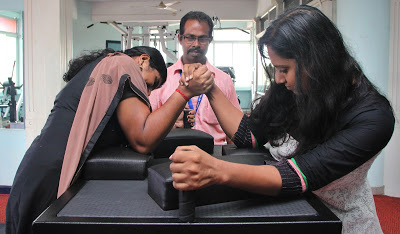
 The employees of the Spices Board, Kochi, have won several medals in arm-wrestling. They are also active members of the organisation's health club
The employees of the Spices Board, Kochi, have won several medals in arm-wrestling. They are also active members of the organisation's health clubBy Shevlin Sebastian
Photos by Albin Mathew. Reshmi EG (left) and Nileena Boban testing their skills. Coach VJ Xavier (centre) watches keenly; Nileena Boban strengthening her arms
On a Wednesday afternoon, Nileena Boban and Reshmi EG stood on either side of an arm wrestling table and gripped each other's right hand. Suddenly, Reshmi pulls her hand off, as it is sweaty. She wipes her palm on her black salwar kameez. Then they grip hands once again. This time, Nileena and Reshmi hold steady for a while, both exerting matching pressure. The spectators watch silently. Then, suddenly, Nileena leans forward, uses a better technique, and downs Reshmi's hand on the padded cushion.
What is unusual about this event is that it is taking place in the Spices Board office at Kochi. Amazingly, many of the women employees are district, state and national-level winners in arm wrestling.
And it all happened rather accidentally. In January, the chairman, Dr. A. Jayathilak suggested that there could be a healthy competition among the staffers during the New Year day celebrations. So, an arm wrestling contest took place. Two weeks later, there was a news item in the newspaper: a district-level arm-wrestling competition was going to take place at Kochi.
“The Chairman said that we should participate,” says staffer Ancy M. John. “When we took part we got a shock because we won many medals, even though we had only two days of training. One reason was because there were few women participants. Then we went to the state-level tournament at Kanhangad, in February, and won 15 medals there, while the men won seven.”
Immediately, Jayathilak okayed the purchase of an international-standard arm wrestling table, at a cost of Rs 13,000. “Then we got a former national champion, KS Nobi, to come and train our employees,” says Jayathilak. “The Kerala Arm Wrestling Federation officials also provided support.”
To ensure that they are in fine fettle, there are daily training sessions for the competitors. One period is from 9.30 to 10 a.m., while the other is from 3.30 to 4 p.m.
Thereafter, the Spices Board sent a team to the national championships at Bazpur, Uttarakhand, in June. And the women did reasonably well. There were three bronze medal winners: Stephy Antony (55-60 kgs category), G. Aparna (60-65 kgs), and N Thara (65-70 kgs).
For Jayathilak, there have been a few gains so far. “There is a good projection of the organisation in the media,” he says. “When they go for competitions, the employees, from different departments, mingle with each other and become friends. They also made friends with other competitors. In normal circumstances, they might not have done so.”
The wins have helped develop self-confidence. “Overnight, our women employees have become state and national-level medal winners,” says Jayathilak. “These achievements are something to tell their grandchildren about. What is clear is that if women are given opportunities, they will shine, like the men.”
Meanwhile, few know that the arm-wrestling practice sessions are taking place in the health club on the fifth floor. And the idea of starting a club also happened by accident.
In October, 2012, Jayathilak noticed that the medical reimbursement bills of the staff were high. “I told my colleagues that they should do regular exercises, and become healthy,” says Jayathilak. But the staffers replied that they did not have the time to practice at a health club. Because of traffic jams, they had to leave the house early, and it was the same situation in the evenings. “They could only manage some exercise on the weekends,” says Jayathilak.
That was when the chairman had a brainwave. He decided to start a health club at the office. And it is a state-of-the-art club, with all the latest machines, including a treadmill, bench press, and weight machines. “We spent Rs 10 lakh,” he says. “And, most probably, this is the first government organisation in India to have a health club like this.”
And the impact on the employees has been profound. Ancy was a diabetic, who had high blood pressure. She would take medicines regularly. “But when I began exercising regularly at the health club, my health improved. I have stopped taking tablets, my weight has stabilised, and I feel positive and happy.”
Standing next to Ancy is the visually-challenged AR Shibhu. He is an arm wrestler, as well as a power-lifter. “Last year I lifted 240 kgs,” he says. Shibu was the only visually-challenged competitor in the national arm-wrestling championships. “My competitors were very strong,” says Shibhu, who came fifth in his event. “Now I am doing a lot of weight training, to develop my forearms.”
Two years ago, when A Subramanyam entered the health club, he had not done any exercise in his life. But, thanks to the guidance from the coach, VJ Xavier, he started doing power lifting. And, at the state championships, he won a bronze in the 74 kgs category.
“Before I began to do exercise, I used to feel tired at the end of the working day,” says Subramanyam. “But, today, after doing one hour of intense weightlifting, I feel rejuvenated and mentally relaxed. And I get a good night's sleep, too.”
And so does Jayathilak, because of the overall benefits. “There are an all-round positive attitude and an increase in productivity,” he says. “And I am also sure that there will be a long-term decline in the medical reimbursement bills.”
(The New Indian Express, Kochi and Thiruvananthapuram)
Published on October 12, 2015 22:08
October 11, 2015
Solicitors of Symphony
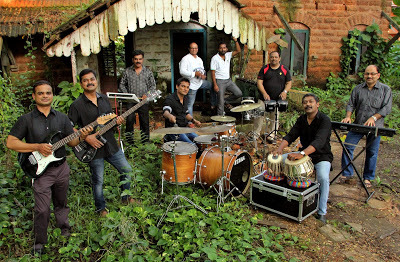 The 'Ragaaneethi' music band is perhaps the only group in the country that consists solely of lawyers
The 'Ragaaneethi' music band is perhaps the only group in the country that consists solely of lawyersPhoto by Albin Mathew
By Shevlin Sebastian
Just before he stepped on stage, at the Fine Arts Hall in Kochi, last year, singer Vijay Yesudas told the 'Ragaaneethi' music band that he would sing four songs. Vijay was a special guest for the 10th anniversary celebrations of the band. But the moment he began singing, he realised that the music being played was 'live'. “Unlike most bands, we don't perform with recorded music,” says band leader KT Shyam Kumar. “Most singers love this because they can improvise and try out new things. Otherwise, it is a mechanical process.”
So excited was Vijay by this 'live' performance, that he ended up singing 12 songs and stayed for two hours. At the end, he told the audience, “There are so many professional orchestras which do not play as well. All the band members have such good talent. And they sound so wonderful in a live performance.”
The unusual thing about 'Ragaaneethi' is that the eleven-member team consists solely of lawyers who practice in the Kerala High Court. “I believe we may be the only lawyer band in India,” says a smiling Shyam.
Apart from playing in several events in the legal fraternity, like the South India Judges' Conference, they also do charity shows. “Since we are already earning a living, as lawyers, we play for free,” says Shyam. “This is a passion for us.”
Recently, at the invitation of the Kochi Biennale Foundation, they took part in its Arts And Medicine programme, which is held, once a week, at the General Hospital. “We opted to play only melodious songs, so that the patients and by-standers could feel soothed,” says percussionist Harish R Menon.
Indeed, they were. One bystander, a 60-year-old woman told Harish, “Your songs are wonderful. I come, on every Wednesday, to buy medicines, but also to listen to the music.”
On another occasion, the band played for the female inmates of a juvenile home. “The girls were so happy that they started dancing in an impromptu manner,” says lead guitarist George Johnson. “One girl even came on stage and sang a song. It was the first time they were listening to 'live' music. They did not have any contact with the outside world. There was a profound joy on their faces. We felt happy seeing that.”
Incidentally, the lawyers got together as a group when they decided to do an instrumental ensemble for the annual-day celebrations of the Kerala High Court Advocates’ Association. Since their performance was much appreciated, they decided to set up a full-fledged orchestra. The other members include percussionist Manoj Chandran, bass guitarist Anand Parathara, drummer John Didymos, Sunil Dutt on the tabla and singers, Vipin Das, Jai George, and Carol Alenchery.
Asked the meaning of the word, 'Raaganeethi', Harish says, “It was coined by our guitarist, PK Raveendran, who, sadly, passed away two years ago. While Raaga is a music term, Neethi means justice. So, in essence, we are doing justice to music.”
And in order to do justice to the audience, the band trains as often as possible. However, because of their legal commitments, they usually practice on the weekends.
This is usually at Shyam's home, where he has set up a music studio. Rehearsals usually begin at 7 p.m., and it can go on till midnight. The repertoire includes popular Malayalam songs, ghazals and fusion music. “That always goes down well with the audience,” says Vipin.
Interestingly, most said that if they came of age today, they would have opted for music as a career. “Today, there is an ocean of opportunities for musicians,” says Shyam. “There are so many television channels, Mollywood films, and so many entertainment programmes for corporates. It can be lucrative.”
Nevertheless, there are other gains. Band members say that they have become better lawyers. “Being a good lawyer means to be a good performer in front of the judge and the court,” says Shyam. “Our experience on the stage helps us to perform better in court. Our concentration levels are higher. We are also happier and positive-minded because we are doing what we like. It is a form of meditation.”
(Sunday Magazine, The New Indian Express, South India and Delhi)
Published on October 11, 2015 22:20
October 9, 2015
A Touch of North India in the South
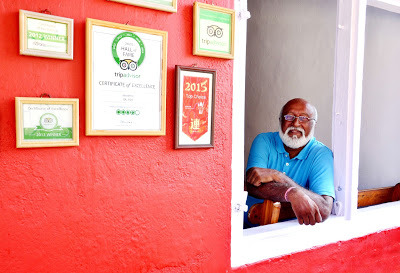 Dal Roti in Fort Kochi, which serves authentic north Indian food, is a popular stop for tourists as well as locals
Dal Roti in Fort Kochi, which serves authentic north Indian food, is a popular stop for tourists as well as locals By Shevlin Sebastian
Photo by Ratheesh Sundaram
After a while, Carlota, 40, got up, went to the Coelho table, and asked Emilia, “Are you from Portugal?”
“No,” said Emilia. “I am from Mexico.”
They started talking, exchanged names and got a shock. Both Carlota and Emilia were classmates in school in Mexico when they were four years old. So excited were the two women to see each other, that Carlota, who was scheduled to fly out the next day, cancelled her ticket so that the two women could spend time with each other.
“It was such an unforgettable experience,” says Dal Roti owner Ramesh Menon. “In fact, both of them thanked me for somehow engineering this meeting between the two.”
Dal Roti is an unusual place. It is the lone eatery in Fort Kochi that only serves North Indian food. Ramesh started this 3000 sq. ft. restaurant, which seats 60, on January 4, 2007, when his North Indian wife, Kalpana, complained of eating South Indian food all the time.
“Like my wife, there are many north Indian tourists who come to the restaurant and beg me, ‘Sir, please make some dishes without curry leaves and coconut. We are tired of eating Malayali food’,” says Ramesh.
Expectedly, the cuisine is authentic North Indian stuff, like Mughlai parathas, paneer, kheema, biriyani and kofta, because the chief cook, Mumtaz Khan, as well as his assistants, are from Uttar Pradesh, Bihar and Madhya Pradesh.
When Ramesh went searching for chefs he deliberately avoided those who worked for five-star hotels. “They tend to neutralise food because they are looking for consistency in flavour,” says Ramesh. “So the food lacks the punch of natural cooking. But whenever people cook for a wedding feast, they need to provide quality fare. Otherwise, they will not be called again. All my chefs used to cook for weddings.”
Apart from having authentic cooks, Ramesh’s USP is that he ensures there is very little spice in the food. “I have always felt that if you add chillies, you can no longer taste the cardamom or the cloves,” he says. “The taste should be subtle.”
Also, unlike most owners, Ramesh is a hands-on person. “It is unusual for an owner to talk to the customers,” he says. “But I have no such problems. I suggest food items, take the order, and serve the food myself. In India, where there is a strong separation between the white and blue collar, here is a white-collar guy doing a blue-collar work. But in this business, the personal touch makes a restaurant successful.”
Indeed, Dal Roti is doing well. There are many patrons from Europe and America. Some are unpredictable. One man came in, wearing torn jeans and t-shirt, with bedraggled hair. At the end of the meal, when Ramesh exchanged visiting cards, the man turned out to be a scientist with NASA. Best-selling US-based author Chitra Banerjee Divakaruni comes whenever she is in Kochi. (Sunday Standard, New Delhi, and New Indian Express, Thiruvananthapuram and Kochi)
Published on October 09, 2015 23:04
October 7, 2015
Understanding An Ancient World
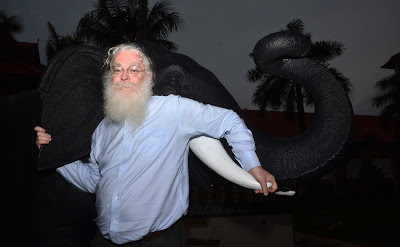
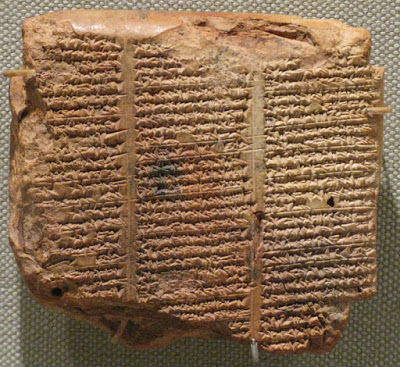
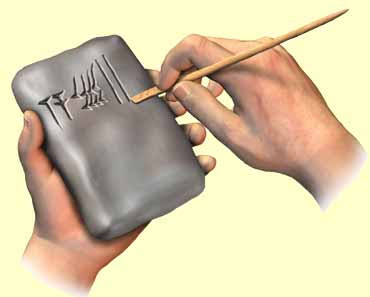 By reading cuneiform tablets, Dr. Irving Finkel, of the British Museum, has been able to understand the life and times of the Mesopotamian period
By reading cuneiform tablets, Dr. Irving Finkel, of the British Museum, has been able to understand the life and times of the Mesopotamian periodPhoto of Dr. Irving Finkel is by Ratheesh Sundaram; a Mesopotamian cuneiform tablet; a reed stylus which was used in those times
By Shevlin Sebastian
A steady summer breeze is blowing. At the seashore, on Willingdon Island, Kochi, the silver hair of Dr. Irving Finkel is blowing about. But Finkel's mind is far away. In fact, it has gone three thousand years into the past. And that is no surprise.
The Assistant Keeper of Ancient Mesopotamian script, languages and cultures in the Department of the Middle East in the British Museum has spent his entire life doing research about the ancient Mesopotamian civilisation. What has helped his research is the 1.3 lakh cuneiform tablets, written in the Babylonian language, at the British Museum, on which has been etched the life of those times.
“There are letters between businessmen,” says Finkel. “One asks the other why he has not paid the money due to him. The people understood the difference between good and evil. And when a king took the throne for the first time, he published a statement stating that, unlike the previous ruler, he would be looking after the poor and the sick, and there would be safety on the roads.”
A smiling Finkel says that these are same promises that are being given now also. “The more time I spend in reading these inscriptions, the more it seems to me that nothing has changed in the world,” he says. “Human behaviour is the same.”
In fact, like now, in Babylon, most people had monogamous relationships. “For a marriage, a contract had to be signed, with witnesses,” says Finkel. “There were all sorts of lawyers. And the legal language was complicated, just like it is today.”
And, like the present, women also felt vulnerable. “If she failed to conceive, or produce a son, these could be sufficient grounds for divorce,” says Finkel, who had come to give a lecture at Kochi, on the invitation of the Kochi Muziris Biennale Foundation, the Association of British Scholars, Thiruvananthapuram & Kochi Chapters, and the British Council.
It is one of the miracles of nature that the tablets have lasted for thousands of years. But the documents were made very simply. “Cuneiform tablets are made of clay, taken from the banks of rivers, like the Tigris,” says Finkel. “They used a reed stylus to impress symbols on it. Afterwards, they put it outside, but not in direct sunlight, so that it became hard enough to handle safely.”
As for the size, it is amazingly like the dimensions of a smartphone. “It fits in the hand,” says Finkel. “The writers were well trained. They had a proverb: a good scribe follows the mouth. It meant that they could keep up with the speaker. And as for the reed stylus, it is tough and resilient. It has a sharp end. You can write at least ten tablets before you need to sharpen it.”
Like the stylus, Finkel has a sharp brain. So, one day, in 1997, when a 38-year-old man called Douglas Simmonds came into the Museum, and showed a cuneiform tablet, Finkel's eyes lit up. The tablet was given to Simmonds by his father, who had got it while serving in the Royal Air Force at Egypt during the Second World War.
Simmonds asked Finkel aabout the contents. “It is a story about a great flood, and how a king had told the people to build a large boat so that they could survive,” said Finkel.
Finkel's conclusion: the story of Noah's Ark and the Big Flood existed a long time before the events mentioned in the Bible. “The authors of the Bible were recycling an ancient story,” says Finkel.
And, interestingly, the boat in the Bible has been described as an oblong craft. However, most people often visualise Noah’s Ark, with a house on it,along with a high prow and stern.But on the tablet, it is described as a coracle, which is circular in design. “In fact, there are instructions on the tablet on how to make such a boat,” says Finkel. “It is 3,660 sq. m, with a wall of seven metres.”
Last year, on the Punnamada Lake, at Allapuzha, Finkel made a giant coracle, with the help of experienced boat-makers from Italy and local craftsmen, based on the instructions on the tablet. After a lot of trial and error, the boat was ready and Finkel was able to float it down the backwaters. So imagine Finkel's chagrin, that when he was passing by a houseboat, which contained a few Westerners, one of them shouted, “Oh look, there is Noah's ark.” However, Finkel says, in their defence, they could not see, from a sideways glance, that it was round.
Incidentally, in January, this year, Finkel published a book, called 'The Ark Before Noah - Decoding The Story Of The Flood'.
When you speak to him, there is no doubt about Finkel's passion for ancient history. And it happened by accident. He went to the University of Birmingham to study Egyptology. “But in the very first week, the professor dropped dead,” he says. “The head of the department called me and said it would take a year to find a replacement. He suggested that I knock on Prof. Wilfred G. Lambert's door and learn a bit of his Babylonian cuneiform. And when the University got an Egyptologist, I could come back.”
But Finkel never went back.
(The New Indian Express, Kochi and Thiruvananthapuram)
Published on October 07, 2015 21:25
October 6, 2015
The Steelman of India
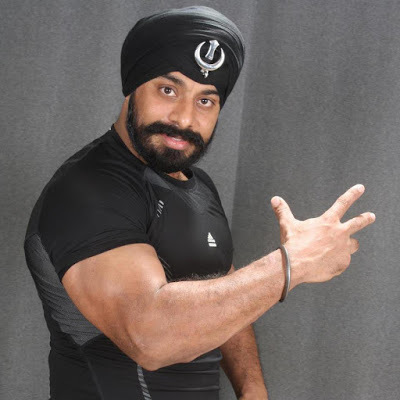 On a recent visit to Kochi, Amandeep Singh talks about he allows cars to go over his body and get hit by sticks and hammers, with no discomfortBy Shevlin Sebastian
On a recent visit to Kochi, Amandeep Singh talks about he allows cars to go over his body and get hit by sticks and hammers, with no discomfortBy Shevlin SebastianAmandeep Singh lay on the floor on a stage in Mumbai. A brick was placed next to his head. His colleague revved up the engine of a bike, turned up the accelerator, and headed towards Amandeep. He rode onto the brick, over Amandeep’s head, and was gone. Amandeep shook his head and got up within seconds. Then another volunteer took a hammer and hit him hard on the chest. Nothing happened. Then he was hit by several sticks. Again, no problems. Then he effortlessly lifted a bike which weighed 130 kgs.
So, is it any wonder than Amandeep is known as the Steelman of India? He has taken part in numerous programmes, on television channels, and on stages all over India, as well as Hongkong and Dubai.
Asked how he can withstand these assaults on his body, Amandeep says, “You need a strong willpower. I stop breathing and keep my body in a state of heightened tension. I also pray to God to give me the strength. When a car goes over my buttocks, the pain will last for two minutes, and then it is gone. But I have also done many years of practice. So my body is used to it.”
But sometimes things can go wrong. Once, while performing in Mumbai, his regular car driver was not present. So a replacement got into the Scorpio. However, instead of driving over Amandeep’s buttocks, the driver took the car over the knees. For a few moments Amandeep felt dazed. Then he got up and continued with the programme. “By the grace of God nothing happened,” he says. “But after the show when I looked at my knees, the entire area had turned a bluish colour. Thankfully, it vanished after two days.”
To maintain his toughness, Amandeep has to go through a tough daily schedule, at his hometown of Ismailabad, Haryana. “Every day, I do about 2500 pushups, 180 kgs of bench press, and I lift weights of 250 kgs,” he says. “I also get punched about 3000 times.” In total, he spends six hours in the gym. He also does an early morning six-kilometre run. But just before that, he drinks one large jug of water. “It removes all the toxins inside my body,” he says.
Not surprisingly, he eats a lot. These include plenty of eggs, vegetables, rice and chappatis. “I drink two kilos of milk every day, along with oats,” says Amandeep. “Throughout the day I am having fruits and juice.”
And he is on a mission to inspire youths to follow his way of life. “There are 2500 students to whom I am giving free training, either directly or through WhatsApp,” he says. “I am trying to lure them away from drugs and become a physically powerful person like me.”
Amandeep says that in the states of Punjab, Haryana and Rajasthan, there is an alarming increase of drug-addiction among the youth. “To get the votes, the politicians give drugs to the youth,” he says. “For them, drugs is a big business.”
Apart from his shows, Amandeep is busy preparing for the Ultimate Fight Championship to be held early next year at Hongkong. “This consists of boxing, wrestling, and kicking,” says Amandeep. “You have to defeat the opponent at any cost. There is no protection.”
He is being sponsored by Sikh organisations, like Tiger Jatha and Singh Naad Radio of Britain, and the Hongkong Gurudwara Committee.
“It will be a big test for me,” says Amandeep, while on a brief visit, his first, to Kochi.
And he likes everything about the city. “Kochi is a beautiful place,” says Amandeep. “The people respect me a lot. They have a clean heart and look happy. I felt a peace of mind here. Nobody interferes with each other. The food is also tasty and cheap.”
(The New Indian Express, Kochi and Thiruvananthapuram)
Published on October 06, 2015 22:14
October 5, 2015
A Multi-Faceted Talent
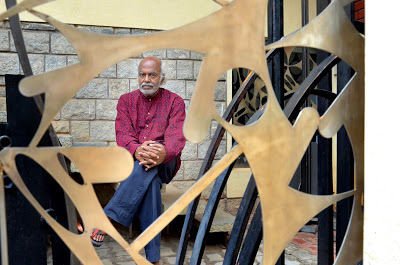 Balan Nambiar, who was recently conferred with the Raja Ravi Verma Puraskaram, Kerala state's highest art award, is adept at many art forms. He is a painter, enamellist, photographer, academic researcher, as well as a sculptor
Balan Nambiar, who was recently conferred with the Raja Ravi Verma Puraskaram, Kerala state's highest art award, is adept at many art forms. He is a painter, enamellist, photographer, academic researcher, as well as a sculptorPhoto by M. Jithendra
By Shevlin Sebastian
Artist Balan Nambiar felt disappointed. During the September 7 ceremony, organized by the Kerala Lalitkala Akademi, at Kochi, to present him with the Raja Ravi Verma Puraskaram, the highest state award for art, there was hardly anybody present from the artistic fraternity. “There were twenty adults in the audience,” he says. “The rest were filled by students of the fine arts colleges. There were two people on the dais who were supposed to give felicitation speeches, but none of them had seen my original work.”
It is no surprise that Nambiar left Kerala a long time ago. “Kerala is yet to become a haven for an artist,” he says. “Not many can thrive here. There is inadequate encouragement or patronage by cultural institutions. And there is a lack of critical responses to art works. Instead, all you get is indifference. That is the worst enemy for an artist.”
Today, the Bangalore-based Nambiar is respected as a multi-faceted talent: a painter, enamellist, photographer, academic researcher, as well as a sculptor. .
His stainless steel sculpture, 'Valampiri Shankha', commissioned by Texas Instruments (TI) and displayed at the Indian Institute of Science in Bangalore, is a striking piece of work. “It is in the form of a conch shell,” says Nambiar. “When a conch is blown, it produces a sound which is closest to the 'Om' sound.” Incidentally, TI are the pioneers of digital sound processing in India. The sculpture gained an entry in the Limca Book Of Records as the largest steel conch shell in India.
Asked why he uses stainless steel, Nambiar says, “It is a durable medium. Ordinary steel gets corroded after a period of time.” Thus far, Nambiar has done over a hundred stainless-steel sculptures.
He is also adept at painting, both in oils and acrylic. While his earlier works were inspired by nature and the ritual art forms of South India, at present his themes are the symbols of growth, energy and mathematics. “The Golden Ratio and Fibonacci Numbers (mathematical concepts) recur often in my work,” he says. He has also done several enamel paintings, having learned the method from the Italian maestro, Paolo De Poli.
What will be an enduring achievement is the way he has tried to preserve the ancient art forms like Theyyam, Buta, Patayani, Nagamandala and other forms through photographs. So far, he has a collection of 12,000 photographs. Around 1800 of them have been acquired by the Indira Gandhi National Centre for the Arts. To do the research, he was awarded the prestigious Nehru Fellowship as well as a Senior Fellowship from the Ministry of Culture.
Unfortunately, all these art forms are declining in importance. “They are being diluted, and the spectacular elements are highlighted,” says Nambiar. “The worst aspect is the use of the loudspeakers during an event in the villages. Sometimes, advertisements are blared through the speakers even as the mantras are being recited. This has reduced the sanctity.”
Nambiar is understandably upset because he has an emotional bonding, especially with the Theyyam art form. “I have seen Theyyam performances as a child in my village [Kannapuram, Kerala],” he says. “They would make their ritual costumes from tender coconut leaves.”
A son of a farmer, Nambiar showed an aptitude towards art and mathematics from an early age. “My parents neither encouraged nor discouraged me,” he says. When he grew up, he went to Chennai and got a diploma in Fine Arts (Sculpture) from the Government College of Arts & Crafts. Thereafter, he ventured onto a career in the arts.
Nambiar has displayed his work in places like the Venice Biennale as well as the Constructa78 in Hannover and is part of the permanent collection of many museums in India.
“I have lived by art for the past 49 years,” says this former chairman of the Lalitkala Akademi of New Delhi. “When I look back, I realise that I am one of the fortunate people. From the very beginning I was able to sell my work. And I have got all the recognition and creative satisfaction possible in my career.”
(Sunday Standard Magazine, New Delhi and New Indian Express, Kochi and Thiruvananthapuram)
Published on October 05, 2015 22:07
October 4, 2015
In Love With Elephants
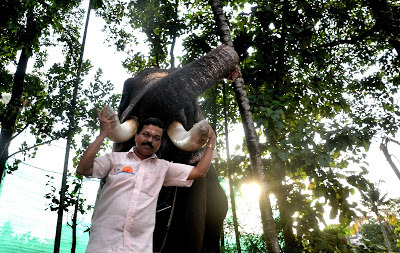 TV Satheesh has provided pachyderms for temple festivals, organised foreign tourists to see them, and is a broker, as wellPhoto by Ratheesh Sundaram
TV Satheesh has provided pachyderms for temple festivals, organised foreign tourists to see them, and is a broker, as wellPhoto by Ratheesh Sundaram By Shevlin Sebastian
The sixteen-year-old TV Satheesh had been pestering the mahout, Unni, to allow him to sit on the elephant Sivankutty. This was at the Hari Hara Sudha Temple at Kochi. Finally, Unni consented. Immediately, the elephant folded his legs and sat down. Satheesh climbed up by grabbing one of the ears.
Usually, there is a rope around the neck, to hold on to, but there was none on Sivankutty. Somebody then gave Satheesh a three-year-old boy to hold. Meanwhile, as Sivankutty stood up, just to tease him, Unni raised his stick. A mahout does this several times a day, but he rarely hits the elephant. But on this occasion the elephant got scared. And he ran away outside the temple and down a narrow street.
“I felt terrified that I would fall off,” says Satheesh. “There was nothing to hold on to, and I had the child with me.” A desperate Unni chased the elephant. Down the street Sivankutty ran, scaring away the pedestrians. Thankfully, there were no vehicles. However, after 400 metres, Sivankutty stopped suddenly at a leaking public tap and began to drink water. This gave Unni the chance to bring things under control. Despite this traumatic experience, Satheesh fell in love with elephants.
Today, thirty years later, Satheesh arranges elephants for temple festivals, takes foreigners to places where elephants are staying, so that they can have an interaction, and gets the pachyderms transferred from person to person. For arranging this deal, Satheesh gets a commission from both parties.
However, as per the 1972 Kerala State Wildlife Act, elephants cannot be sold. Instead, they can be leased out. The current prices range from Rs 50 lakh to 10 crore. When a deal is done, there is a ceremony between the lessor and lessee. The lessor has to tell the elephant, “This is your father.” When the pachyderm hears this, it starts crying. “The elephant knows what is happening,” says Satheesh. “The relationship between owner and animal is, indeed, like father and son. So, if a man has a five-year-old son and an elephant, which is 10 years old, then the animal is the elder son.”
Asked how he figures out which are the best elephants, Satheesh says, “I check to see if there are indentations on the temples. The deeper it is, the older is the elephant,” says Satheesh. “Sometimes, there are wrinkles on the legs and the body. Their prime is from 18 to 50 years.”
But what pains Satheesh is the cruelty meted out to elephants. “Sometimes, mahouts destroy one eye, because it becomes easier to control the elephants,” says Satheesh. “There are cruel mahouts who destroy both eyes by hitting them with a stick.”
In Kerala, during the five-month temple festival season, the elephants hardly get a moment's rest. They are moved from place to place by lorry.
“It is so difficult for elephants to maintain their balance on a vehicle,” says Satheesh. “If the driver brakes suddenly, their tusks will hit the wooden boards. Their bodies bang on the sides when the lorry turns to the left or the right. By the end of the journey, they are exhausted. And the moment they arrive, they have to be dressed up, to take part in the festival, which has loud music, from traditional drums, noisy firecrackers and the presence of thousands of people.”
The food is also never given on time. “Only when the festival is over, are they fed,” says Satheesh. “They like to eat grass and leaves, but they are usually given the cheaper coconut fronds and palmyra palms, which they don't like. Simply put, they are in hell.”
Despite that, elephants have a golden heart. “Once, a mahout, owing to severe low blood pressure, fell unconscious next to an elephant,” says Satheesh. “Immediately, it ran on the street and blocked traffic and made people aware of the fallen mahout. Subsequently, the man was rushed to hospital, where, thankfully, he recovered.”
An emotional Satheesh says, as he provides bananas to Kandathil Sudhir, an elephant that belongs to his friend, Martin, “This is the beauty of elephants. When they love you, it is wholeheartedly.”
(Sunday Magazine, The New Indian Express, South India and Delhi)
Published on October 04, 2015 21:45
September 30, 2015
A Love Stanza
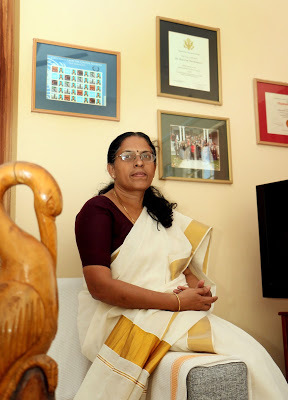
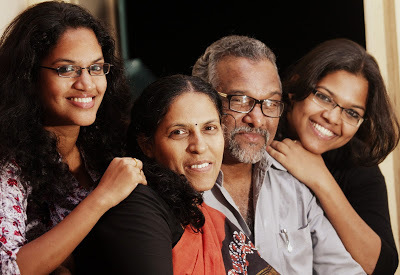 COLUMN: Spouse's Turn
COLUMN: Spouse's Turn Sadhana talks about life with the poet TP Rajeevan
Photos: Sadhana Raghavan; (from left) Sreedevi, Sadhana, TP Rajeevan and Parvathy. Photos by TP Sooraj
By Shevlin Sebastian
Sadhana met the poet TP Rajeevan for the first time, in 1982, at the NSS College at Ottapalam. They were both in the same MA English class. “He was wearing a green kurta and brown trousers,” says Sadhana. “I regarded him as a classmate.” Sometime later, Sadhana came to know that Rajeevan was a poet.
Both were part of a group that would attend literary meetings. Once, they went to see Prof. MA Rahman's documentary on Vaikom Mohammed Basheer. “We both enjoyed it,” she says.
Right from the beginning, Rajeevan established his style of publishing sparingly. “He would write a poem and then rewrite it a lot,” says Sadhana. “Sometimes, he would take a year doing this. After that, he would go and show it to [senior poets] Atoor Ravi Varma and K G Sankara Pillai at Thrissur. Sometimes, I would accompany him. Both of them liked Rajeevan's style.”
Meanwhile, one day in 1986, when Sadhana was doing her M. Phil at the University of Calicut, Rajeevan told her that they should start their lives together. “That was when I realised he wanted to marry me,” says Sadhana. “I had only looked at it as a friendship. But when he said this, I knew that if I agreed it would deepen our bond.”
At her home, in Ottapalam, Sadhana's parents were receiving marriage proposals for their daughter. So she told her parents about Rajeevan's desire to marry her. “He had come once or twice to the house, so they had met him,” says Sadhana. “My parents did not object. They said they would find out more about Rajeevan's family. Thereafter, it became like an arranged marriage.”
While all this was going on, in May, 1988, Sadhana got a job as an assistant in Calicut University, while Rajeevan was working in various newspapers in Delhi. Eventually, the marriage took place on September 12, 1988, at Ottapalam. And, immediately, there was good news for Rajeevan. He got a job as a public relations officer at the University of Calicut. And, on October 1, he was conferred with the VT Kumaran poetry award at Vadakkara.
Asked to list her husband's qualities, Sadhana says, “Rajeevan has got a third dimension. If I say something, he is always able to find an unique angle. This is the case with anybody who meets him. He is very sincere in his words and behaviour.”
And hard-working, too. Rajeevan began work on his first novel, 'Paleri Manikyam: Oru Pathira Kolapathakathinte Katha', in 1988, and took 12 years to complete it. “There are details about forensic investigations,” says Sadhana. “Rajeevan ensured that he got the technical facts right by reading books about the subject.”
Meanwhile, as a father, to Sreedevi, 25, and Parvathy, 23, Rajeevan has always been like a friend. “He gives advice and encourages them to do whatever they like,” says Sadhana. While Sreedevi is doing her M. Phil from the Tata Institute of Social Sciences at Mumbai, Parvathy, who has a MA in journalism, is working for a company in Chennai.
As for his negative points, Sadhana says, “Rajeevan is short-tempered. He will say what is in his heart, although he will cool down quickly. But some people keep the resentment in their hearts. So, he has a few enemies.”
But Sadhana has been his best friend right from the beginning. When Rajeevan wants to write, she will ensure that there is peace and quiet in the house. “When he gets engrossed he forgets to take his meals,” says Sadhana. “Rajeevan does not have a fixed routine while writing. When he is working on a novel, he can work for five to six days at a stretch. On other days, he will not write at all.”
Sometimes, he shows Sadhana what he has written. “I give my honest opinion,” she says. “Rajeevan is keen to know whether readers will like it.”Meanwhile, Rajeevan's turning point occurred when he was invited to take part in the Struga Poetry Evenings Festival at Macedonia in 2002. “He interacted with a lot of poets from all over the world,” says Sadhana. “One of his poems was adjudged as the best in the festival. It gave Rajeevan a lot of confidence. He grew up in a village [Palery, in Kozhikode district], so he felt inhibited for many years.”
Thereafter, Rajeevan attended poetry festivals in Poland, Croatia, Israel, and the USA. He was awarded the International Visiting Programme Fellowship by the US Department of State in 2004. Rajeevan also received a Ledig House International Writer-in-Residence Fellowship in 2008 at New York, as well as the Rockefeller Foundation’s writer-in-residence fellowship at Bellagio, Italy, in 2013.
Asked how Rajeevan has changed over the years, Sadhana says, “He has become peaceful and relaxed. In the beginning, he had been tense about how his career would shape up.”
Finally, when asked to give tips for a successful marriage, Sadhana says, “Both spouses are individuals in their own right. So, you should respect each other. There should be sincerity and transparency between husband and wife. We should always communicate with each other so that there are no misunderstandings.”
(The New Indian Express, Kochi and Thiruvananthapuram)
Published on September 30, 2015 22:05



